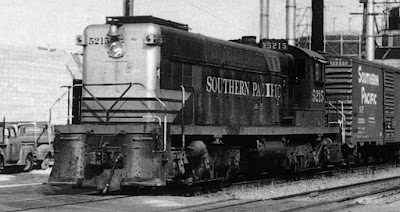To me, it’s an interesting footnote in locomotive history that Southern Pacific was quite a customer of Baldwin diesel road switchers, almost from when they were first introduced. Baldwin, of course, was eventually not terribly successful in the diesel locomotive market, but they had road switcher models before either Alco or EMD did. SP eventually owned over 80 of them, plus ten to T&NO (see Joe Strapac’s Volume 11 in the series, Southern Pacific Historic Diesels, “Baldwin Switchers and Roadswitchers,” Shade Tree Books, 2005).
And we know that they were used out of San Luis Obispo, according to Mac Gaddis, who worked there. For a portion of one of my interviews with him, see this link: http://modelingthesp.blogspot.com/2011/08/san-luis-obispo-operations-3.html ). The area of California that I model is only about 20 miles south of San Luis Obispo (for more about my layout locale, see: https://modelingthesp.blogspot.com/2019/08/conveying-ones-layout-locale.html .)
The first of SP’s 6-wheel Baldwin road switchers were model DRS-6-4-1500, meaning “Diesel Road Switcher, 6 axles, 4 motors, 1500 horsepower,” only three units, arriving in 1948. They were followed by 6-motor units, DRS-6-6-1500, numbered 5203–5212, in 1949. Though delivered in full “Tiger Stripe” paint, as were ordinary switchers, they soon received aluminum end paint. Below is a 1950 photo of SP 5212 on the ready track at Taylor Roundhouse (Stan Kistler).
There was a Stewart HO scale model which was quite close to these early DRS-6-6-1500 engines, and my model was re-detailed, painted, crewed and given a decoder by Al Massi. Here it is passing the Shumala depot with the Guadalupe Local:
In 1954, after my modeling year of 1953, SP decided that these were really road locomotives, and the orange striping went away over the next four years, engine by engine, to be replaced with normal road power “Black Widow” silver and orange wings. Here’s an example, a photo at West Oakland in 1959 (Don Hansen photo).
Apparently SP was pretty happy at first with the DRS 6-6-1500 locomotives, because in early 1950 they received 14 more, SP 5213–5226. Externally they were quite similar in most respects to the preceding group of locomotives; probably the most visible aspect for modelers is that they had dynamic brakes, with open grilles over the resistor grids in the short hood.
By the summer of 1950, Baldwin upgraded this locomotive to 1600 horsepower with a new supercharger, and designated it as model AS-616.The first models produced went to SP, delivered from September 1950 to spring 1951, 28 units numbered SP 5228–5249. In the fall of 1951, SP began to take delivery of yet another order, this time 29 units, SP 5250–5278. Again, all were delivered with the modified “road” version of the Tiger Stripe scheme (aluminum ends), but in 1954, all began to be repainted into the Black Widow style of road service power.
I have a Hallmark brass model of the Baldwin AS-616 locomotive, with dynamic brake grilles on the short hood (as it should have), and I painted and lettered it myself, as SP 5249. Below it’s shown with the Surf Local returning westward to San Luis Obispo, here just passing the Shumala engine terminal.
The trouble here is that this would be an awfully early repaint in my 1953 modeling year. This engine is a good puller, but I may sell it on, as not really correct for my era — much as I like the paint scheme.
We know that Baldwins were the only SP road switchers in the early transition era, and even by my modeling year of 1953, the Baldwins greatly outnumbered the first new orders for Alco and EMD engines of that type, which all arrived during 1953. So it’s essential that I have at least one in my layout operation. Heck, I may even need another one in Tiger Stripes to replace the 5249!
Tony Thompson




The locomotive SP 5249 is very beautiful, it should be kept!
ReplyDeleteTony, are those roof mounted, angled number boards an SP addition?
ReplyDeleteYes. As built at Baldwin, they were toward the front of the locomotive hood, but SP moved them back to the cab front (operated long-hood forward, of course).
DeleteTony Thompson
Very nice model work, all of it. Your engines really look excellent.
ReplyDeleteI've taken a liking to the SP/T&NO #181 and I am thinking about modeling it. The era would be 1964. Do you happen to know the delivery date for the #181?
The 8 Baldwin units in that T&NO order, engines 177-184, were built in January 1952.
DeleteTony Thompson
On some prototype pictures, it looks like something is behind the number boards. Is it the horn? If so, what type is it?
ReplyDeleteAlso, can you tell me what number boards you used on your model?
What looks like "behind the number boards" is the stack. I did not replace the model manufacturer's number boards.
ReplyDeleteTony Thompson